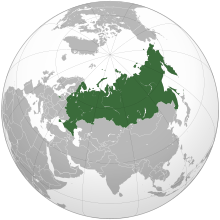More languages
More actions
Российская Федерация | |
|---|---|
 | |
| Capital and largest city | Moscow |
| Government | Federal semi-presidential republic |
• President | Vladimir Putin |
• Prime minister | Mikhail Mishustin |
| History | |
• Proclamation of the Russian Empire | 2 November 1721 |
| 30 December 1922 | |
• Establishment of the Russian Federation | 12 December 1991 |
| Population | |
• 2021 estimate | 146,171,015 |
History
The Russian SFSR declared sovereignty on December 12, 1991[1], even though 73% of the population had voted to remain in the Soviet Union earlier that year.[2] On December 25, Gorbachev resigned and the Soviet Union was dissolved the next day.[3]
Economy
Politics
The ruling party of the Russian Federation is the nationalist party United Russia, which has the majority of seats in the parliament. Vladimir Putin was formerly a member of the party but is now an independent.[4] Other major parties are the Communist Party of the Russian Federation, the social democratic party A Just Russia – For Truth, and the far-right Liberal Democratic Party.
Infrastructure
Demographics
Culture
- ↑ "Постановление Верховного Совета РСФСР от 12.12.1991 № 2015-I" (1991-12-12). Сейчас.ру.
- ↑ "Sowjetunion, 17. März 1991 : Weiterbestand der UdSSR als Föderation gleichberechtigter und souveräner Staaten" (2020-10-07). Database and Search Engine for Direct Democracy. Retrieved 2021-12-29.
- ↑ Zbigniew K. Brzezinski (1997). Russia and the Commonwealth of Independent States: Documents, Data, and Analysis (p. 50). [PDF] London: Center for Strategic and International Studies. ISBN 1563246376
- ↑ "Vladimir Putin quits as head of Russia's ruling party" (2012-04-24). The Telegraph.


